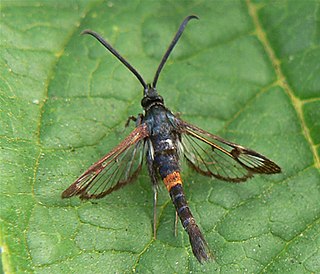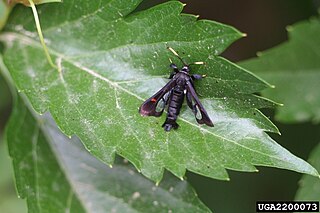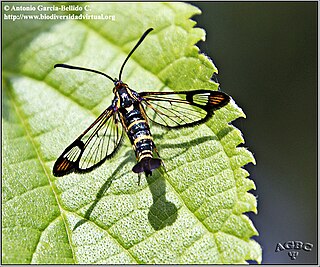
The Sesiidae or clearwing moths are a diurnal moth family in the order Lepidoptera known for their Batesian mimicry in both appearance and behaviour of various Hymenoptera.

Paranthrene tabaniformis, the dusky clearwing, is a moth of the family Sesiidae. It is found in the Palearctic and Nearctic realms.

Sesia bembeciformis, the lunar hornet moth, is a moth of the family Sesiidae. It is found in Europe.

Synanthedon myopaeformis is a moth of the family Sesiidae and the order Lepidoptera. In Europe it is known as the red-belted clearwing and in North America as the apple clearwing moth. The larvae create galleries under the bark of fruit trees, especially old trees with damaged trunks. During this process, the larvae cause significant damage to host trees. Particular attention has been paid to the damage they cause to apple trees. Their status as a pest of apple orchards has led to many research projects aimed at controlling populations of the moth. This moth is native to Europe, the Near East and North Africa. Recently, the moth was introduced into North America, being first detected in Canada in 2005. There are several organisms that threaten the larvae, including parasitoids, nematodes, and bacteria.

Synanthedon tipuliformis, known as the currant clearwing, is a moth of the family Sesiidae. It is endemic to the Palearctic realm, but is an invasive species in the Nearctic realm and the Australasian realm.
Nokona carulifera is a moth of the family Sesiidae. It is only known from Kuranda in Queensland, but probably occurs throughout the western coastal regions of Queensland.
Pseudosesia isozona is a moth of the family Sesiidae. It is found in Queensland, Australia.
Melittia doddi is a moth of the family Sesiidae. It is known only from Queensland, where it was collected near Kuranda.
Melittia chalybescens is a moth of the family Sesiidae. It is known only from Queensland, where it was collected near Kuranda and Mackay.
Ichneumenoptera commoni is a moth of the family Sesiidae which was described by W. Donald Duckworth and Thomas Drake Eichlin in 1974. It is known only from the male type which was collected near Toowoomba in Queensland, Australia.
Ichneumenoptera xanthogyna is a moth of the family Sesiidae. It is known only from locations near Kuranda in Queensland, Australia.
Synanthedon cupreifascia is a moth of the family Sesiidae. It is known only from locations near Mackay in Queensland.
Melittosesia is a genus of moths in the family Sesiidae from Madagascar.
Ichneumenoptera is a genus of moths in the family Sesiidae.

Albuna fraxini, the Virginia creeper clearwing, is a moth of the family Sesiidae. It is known from the northern United States and southern Canada.

Sesia tibialis, the American hornet moth, poplar clearwing borer or cottonwood crown borer, is a moth of the family Sesiidae. It is known from North America, including British Columbia, Colorado, Utah, Michigan, Montana, Washington, California and Arizona.

Synanthedon formicaeformis, the red-tipped clearwing, is a moth of the family Sesiidae and can be found in all of Europe, the eastern Palearctic realm, and the Near East. The larvae sometimes form pear-shaped galls on willows. It was first described by Eugenius Johann Christoph Esper in 1783.

Bembecia scopigera, the six-belted clearwing, is a moth of the family Sesiidae. It is found from central Spain over most of south-western and central Europe, the Balkans, Greece, southern Russia and Ukraine to Turkey.

Synanthedon conopiformis, Dale's oak clearwing, is a moth of the family Sesiidae. It is found in almost all of Europe, except the north.
Synanthedon flaviventris, the sallow clearwing, is a moth of the family Sesiidae. The larvae form pear-shaped galls on sallows.









